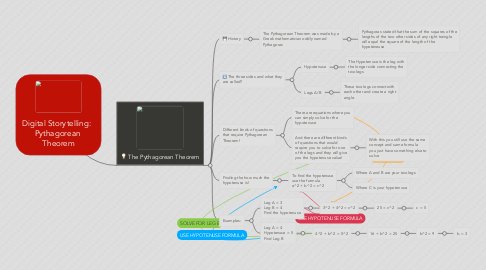
1. The Pythagorean Theorem
1.1. History
1.1.1. The Pythagorean Theorem was made by a Greek mathematician oddly named Pythagoras
1.1.1.1. Pythagoras stated that the sum of the squares of the lengths of the two other sides of any right traingle will equal the square of the length of the hypoteneuse
1.2. The three sides and what they are called?
1.2.1. Hypotenuse
1.2.1.1. The Hypotenuse is the leg with the longer side connecting the two legs
1.2.2. Legs A/B
1.2.2.1. These two legs connect with each other and create a right angle.
1.3. Different kinds of questions that require Pythagorean Theorem!
1.3.1. There are equations where you can simply solve for the hypotenuse
1.3.2. And there are different kinds of questions that would require you to solve for one of the legs and they will give you the hypotenuse value!
1.3.2.1. With this you still use the same concept and same formula you just have something else to solve
1.4. Finding the how much the hypotenuse is!
1.4.1. To find the hypotenuse use the formula a^2 + b^2 = c^2
1.4.1.1. Where A and B are your two legs
1.4.1.2. Where C is your hypotenuse
1.5. Examples:
1.5.1. Leg A = 3 Leg B = 4 Find the hypotenuse
1.5.1.1. 3^2 + 4^2 = c^2
1.5.1.1.1. 25 = c^2
1.5.2. Leg A = 4 Hypotenuse = 5 Find Leg B
1.5.2.1. 4^2 + b^2 = 5^2
1.5.2.1.1. 16 + b^2 = 25
